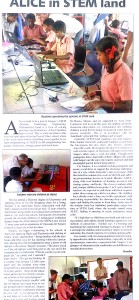Link to PDF – avtoday_ALICE
Article about STEM Land in Auroville Today – Dec 2015
ALICE IN STEMLAND
All you need to be a poet in Sanjeev’s STEM (Science, Technology, Engineering, Mathematics) Land is a love of solving problems and abstractions. A bit of madness helps as well. This is what one finds in this cosy and open space at the top floor of Udavi school, where a few youth and a bunch of children come together to co-learn programming in ALICE (a 3D programming language), electronics, strategy games and much more.
Having earned a Doctoral degree in Electronics and spending most of his life designing chips for a living, Sanjeev is an Aurovilian whose relationship with children’s education and Auroville go back 13 years when he met Subash and Lourdes at an educational conference and came to visit Auroville schools. Subsequent conversations around the exisiting plethora of pedagogical techniques helped shape the initial ideas for the STEM Land. It took 11 more years and an experience in Vipassana for Sanjeev to move to Auroville to test his ideas.
Initially, he began volunteering in the schools in Auroville, teaching Maths and Electronics and sticking to what a ‘good’ teacher does – being familiar with the textbooks and find ways for fun learning within the curriculum. During this time he happened to meet a donor of old laptops to the school. Sanjeev recounts, “The donor asked us if the old laptops were being put to any use and if the computer lab was functional. What do you do in your computer lab,” he asked, and I realised I didn’t know.’ This got me thinking. In a country with around 3.5 lakh computer labs, the children were often using them as a personalised television or to play games – but even the educational games are not entirely convincing in terms of their actual purpose.”
After letting the kids ‘meddle’ with the old laptops and using them to create programmable hardware, Sanjeev finally decided to experiment and start his own ‘lab’. It was during this time he met Bala, an Auroville youth, who along with Sundar and Vaidegi started working on educational interventions in January. Their experiences led them to set up the STEM Land in Udavi school this October. They were inspired by The Stewardship for New Emergence workshop offered by Dr.Monica Sharma and are supported by Aura Semi-Conductors Ltd. to create this space for children, where the classroom intervention was reformulated into enabling children to lead their learning environment rather than be passive recipients. This is in accordance with Sri Aurobindo’s principle that ‘nothing can be taught’.
Currently, STEM Land comprises not only Sanjeev, Bala, Sundar (Auroville youth) and Vaidegi (a youth from the bio-region) but also others like Naveen, another Auroville youth. He frequents the place to volunteer as well as learn aspects of electronics through classes that Sanjeev offers once a week for adults. Though most youngsters leave Auroville or their villages, the youth with Sanjeev are the ones who want to stay back and find meaningful pursuit in their home places.
For Sanjeev, it is essential to retain youngsters and create a workforce to support the electronic infrastructure of a city, which Auroville’s aims to become. With this belief he continues his work in STEM Land, offering programming lessons in Scratch, Blender, ALICE, along with over hundreds of learning resources like strategy games, and books. The classes combine older and younger children from grades 5 to 9, and volunteer teachers are expected to aide them with their requests rather than coming-up with lesson plans. The children have already come a long way in this experiment, with most taking responsibility for choosing their own study topics and finding the means to learn them. Anita, one of the students from Isai Ambalam, particularly enjoys her time in STEM Land, where she recently started using ALICE, finding it amazing to create animations using codes.
“It’s high time we shift from our chalk-and-talk teaching method, and explore shared learning experiences and methods in classrooms”, Vaidegi says. Co-learning and facilitating the experiential learning techniques in STEM Land helps the children understand their subject even more and makes this shared experience rewarding and enjoyable.
In a country with a booming population and increasingly unproductive child-to-teacher ratios, especially in rural environments, innovative experiments like Sanjeev’s are glimpses of alternatives that could make a real difference in our education system.
episteme 6 – Mumbai
We attended a conference on STEM education in Homi Bhabha Centre for Science Education, Mumbai (Dec 15 – Dec 18, 2015) . Several papers were presented. But the one that stood out for me(or maybe those that I understood completely ie, excluding our paper!) was the one on Action Research. I liked it because I could in some ways connect to it. It little bit reminded of the things that happen when I am in class. It was about a needle worker cum teacher trying to bring the students under control. She got help from her facilitator to tackle the issue. I liked it very much. The other one I found interesting was the one about Stemland leadership and fellowship programme(held in the States). It was about a programme for teachers where they were asked do to various activities.
We here at Aura Auro Design have conversations about our classes and children, which I thought was very much similar to Action Research. I learnt from this conference that documenting the work we do in STEM land is important.
Tkinter Toplevel Widget
The Toplevel widget work pretty much like Frame, but it is displayed in a separate, top-level window. Such windows usually have title bars, borders, and other “window decorations”.
The Toplevel widget is used to display extra application windows, dialogs, and other “pop-up” windows.
ref: http://effbot.org/tkinterbook/toplevel.htm


